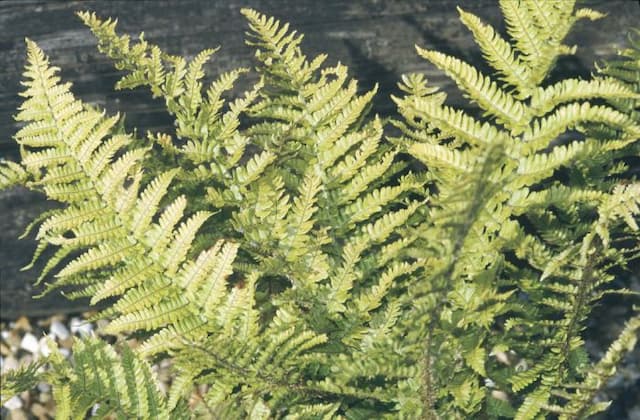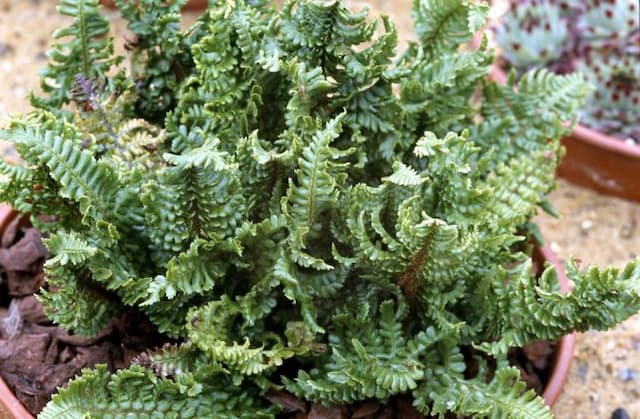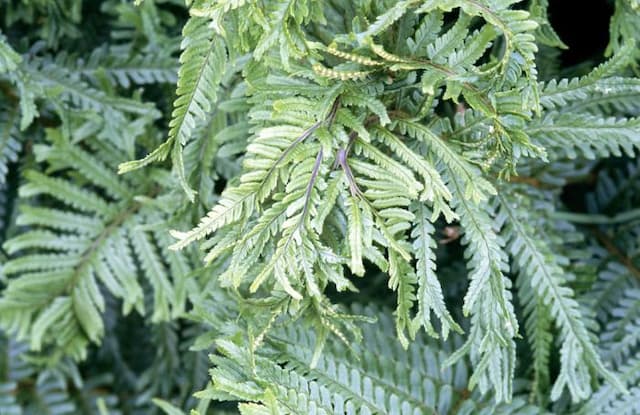Hard Shield Fern Polystichum aculeatum

ABOUT
The plant commonly known as hard shield fern showcases a lush, dark green foliage with a glossy, leathery texture. This fern has fronds which are divided, with each section being further subdivided into smaller, leaf-like parts giving it a complex and feathery appearance. The fronds are arranged in a symmetrical, circular pattern, emanating from a central point, creating an attractive, tufted look. Each frond has a strong, sturdy stem and the edges may appear slightly serrated or toothed, giving the plant added visual interest. The overall form of the hard shield fern is neat and tidy, making it an appealing choice for gardeners looking for plants that provide structured greenery throughout the year.
About this plant
 Names
NamesFamily
Dryopteridaceae
Synonyms
Hard Shield Fern, Prickly Shield Fern, Hard Shield-fern, Prickly Shield-fern
Common names
Aspidium aculeatum, Polystichum lobatum, Polystichum aculeatum var. lobatum, Polystichum aculeatum var. aculeatum, Polystichum aculeatum var. lobatofolium.
 Toxicity
ToxicityTo humans
Hard Shield Fern (Polystichum aculeatum) is not commonly known to be toxic to humans. It is generally considered safe and does not cause poisoning when touched or ingested. However, it is always advisable not to consume any plant material that is not known to be edible, as it could potentially cause gastrointestinal discomfort or allergic reactions in some individuals.
To pets
Hard Shield Fern (Polystichum aculeatum) is also not known to be toxic to pets. It is generally considered non-toxic to cats, dogs, and other animals. As with humans, ingestion of non-edible plants can sometimes lead to mild gastrointestinal upset, but there are no specific toxic effects associated with this fern in pets.
 Characteristics
CharacteristicsLife cycle
Perennials
Foliage type
Evergreen
Color of leaves
Green
Height
2-3 feet (60-90cm)
Spread
2 feet (60cm)
Plant type
Fern
Hardiness zones
5-8
Native area
Europe
Benefits
 General Benefits
General Benefits- Landscape Enhancement: Polystichum aculeatum, commonly known as Hard Shield-fern, adds texture and greenery to shaded garden areas, offering year-round visual interest with its evergreen foliage.
- Habitat Support: The Hard Shield-fern provides shelter and breeding grounds for various species of insects, contributing to biodiversity in a garden ecosystem.
- Erosion Control: The root system of Polystichum aculeatum helps stabilize soil, which can prevent erosion in sloped or delicate areas of a landscape.
- Low Maintenance: Being a hardy fern, it requires minimal upkeep once established, making it an attractive option for gardeners seeking low-maintenance plants.
- Drought Tolerance: Although it prefers moist conditions, Polystichum aculeatum can tolerate periods of dryness, which is beneficial in regions with water restrictions or less frequent rainfall.
- Companion Planting: It can serve as an excellent companion plant for shade-loving flowers and shrubs that require similar growing conditions.
 Medical Properties
Medical PropertiesThis plant is not used for medical purposes.
 Air-purifying Qualities
Air-purifying QualitiesThis plant is not specifically known for air purifying qualities.
 Other Uses
Other Uses- Polystichum aculeatum, commonly known as Hard Shield Fern, has been used in traditional basket weaving due to the durability of its fronds.
- During the Victorian era, the fronds were popularly used in the art of Pteridomania or 'fern fever,' where they were collected and pressed for display in albums.
- The Hard Shield Fern can be used in landscaping to create textured ground cover in shaded gardens or woodland settings.
- Its evergreen nature makes the Hard Shield Fern a natural choice for winter gardens, providing greenery throughout the colder months.
- The plant has been utilized in floristry as a green addition to flower arrangements and bouquets, especially during winter.
- Ferns including this species have occasionally been used as a natural dye source, with various parts of the plant yielding green and brown hues.
- In model railway and architectural models, fine fronds of the Hard Shield Fern can be crafted into miniature trees and shrubs for realistic scenery.
- It has been used as an indicator species in ecological studies to help determine the age of forests or the presence of certain soil conditions.
- Crafters sometimes use the textured fronds of Hard Shield Fern in the creation of nature prints, where the frond is coated with ink or paint to transfer its image onto paper or fabric.
- The plant sometimes serves as a food source for larvae of butterfly and moth species, playing a role in supporting local biodiversity.
Interesting Facts
 Feng Shui
Feng ShuiThe Hard Shield Fern is not used in Feng Shui practice.
 Zodiac Sign Compitability
Zodiac Sign CompitabilityThe Hard Shield Fern is not used in astrology practice.
 Plant Symbolism
Plant Symbolism- Resilience: Polystichum aculeatum, commonly known as Hard Shield Fern, is a plant that can thrive in challenging conditions, symbolizing the ability to endure and persist through difficult times.
- Protection: As a fern, it naturally grows in dense patches which can provide shelter for small woodland creatures. This characteristic lends the Hard Shield Fern a symbolic meaning associated with safety and shelter.
- Permanence: The evergreen nature of the Hard Shield Fern, which retains its leaves throughout the year, symbolizes continuity and everlasting values.
- Secretiveness: Ferns, in general, have a long-standing association with mystery and being carriers of secrets, referencing the ancient belief that ferns possess hidden qualities.
- Rejuvenation: The new fronds of the Hard Shield Fern unfurling in the spring are symbolic of new beginnings and the rejuvenation of life.
 Water
WaterThe Hard Shield Fern needs to be watered regularly to keep the soil evenly moist, but it is crucial not to overwater as it prefers well-drained conditions. Aim to water this fern thoroughly every week with about a gallon of water during the active growing season. Reduce watering to half a gallon every other week during the dormant winter months, allowing the topsoil to dry out slightly between waterings.
 Light
LightThe Hard Shield Fern thrives in partial to full shade, avoiding direct sunlight which can scorch its fronds. It does well under the canopy of taller trees or on the north side of a building where it can receive diffused light, making it perfect for understory planting in woodland gardens.
 Temperature
TemperatureThe Hard Shield Fern is hardy and can tolerate a wide temperature range, from as low as 20 degrees Fahrenheit to as high as 80 degrees Fahrenheit. The ideal temperature for this plant is between 60 and 70 degrees Fahrenheit, where it can maintain healthy growth.
 Pruning
PruningThe Hard Shield Fern benefits from pruning primarily to remove any dead or damaged fronds, which helps maintain its tidy appearance and promotes healthy growth. Pruning should be done in early spring before new growth begins. It's typically not necessary to prune more than once a year unless there's noticeable damage or disease.
 Cleaning
CleaningAs needed
 Soil
SoilHard Shield Fern thrives in a soil mixture that is well-draining and rich in organic matter, with a pH ranging from slightly acidic to neutral (pH 6.0-7.5). You can prepare an ideal soil mix by combining equal parts of garden soil, compost, and coarse perlite or sand, which will ensure proper drainage and fertility.
 Repotting
RepottingHard Shield Fern generally does not need to be repotted frequently. Assess the plant every 2-3 years and repot if it has outgrown its container or if the soil has significantly degraded.
 Humidity & Misting
Humidity & MistingHard Shield Fern prefers high humidity levels, usually around 60-70%. If the air is too dry, the fronds can become crispy and brown, so maintaining adequate humidity is crucial for its health.
 Suitable locations
Suitable locationsIndoor
Place Hard Shield Fern in bright, indirect light with high humidity.
Outdoor
Plant Hard Shield Fern in shaded spot with moist soil and protect from wind.
Hardiness zone
5-8 USDA
 Life cycle
Life cyclePolystichum aculeatum, commonly known as hard shield fern, begins its life cycle when spores located on the underside of mature fronds are released into the environment. These spores germinate to form a small, heart-shaped gametophyte (prothallus), which houses both male and female reproductive organs. Fertilization occurs when motile sperm from the antheridia swim to the archegonia and fertilize the eggs, leading to the formation of a diploid zygote. The zygote then grows into a new sporophyte, which is the familiar leafy fern plant. This sporophyte matures and develops fronds that uncurl from a central rhizome in a characteristic fiddlehead shape. Upon reaching maturity, the sporophyte produces new spores on the underside of its fronds, completing the life cycle and starting the process anew.
 Propogation
PropogationPropogation time
Spring to Summer
The Polystichum aculeatum, commonly known as the Hard Shield Fern, is typically propagated through spores. The best time to collect spores for propagation is in late summer when the sporangia (spore cases) on the undersides of the fronds turn brown and ripe. Propagation via spores involves collecting the spores by cutting the fertile fronds and placing them in a paper bag to dry. Once dry, the spores are shaken from the fronds and sown on the surface of a sterilized compost mix, typically comprised of peat and sand. They require a warm (around 68°F or 20°C), humid environment and indirect sunlight to germinate, which can take several weeks to months. After germination, the tiny fern prothalli (the gametophyte stage) develop, which will eventually give rise to new fern plants when they mature.









